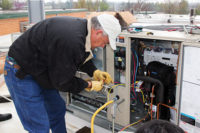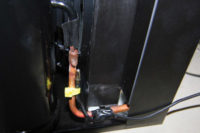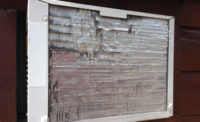The amount of condenser subcooling needed is system dependent. The more pressure drops — friction and static — associated with the lines and accessories that carry the liquid in the system, the more need there will be for liquid subcooling to prevent liquid line flash gas. A quick review of the second article in this series (“Why Is Condenser Subcooling Needed?” published in the March 5, 2012, edition of The NEWS) will remind readers of the differences between friction and static pressure drops.
The only sure way to safeguard against liquid line flash gas is to subcool the liquid before it experiences any pressure drops.
Subcooling can be accomplished by numerous methods. Liquid/suction line heat exchangers, ambient air, and direct expansion mechanical subcooler heat exchangers are common methods. On receiverless systems, simply adding a little more refrigerant to the system can increase subcooling but usually isn’t recommended because of added inefficiencies that may occur.
Now, let’s figure out what the minimal amount of liquid subcooling in the condenser would have to be in order to prevent liquid line flash gas on the way to the metering device.
Assume the following conditions:
• Filter drier pressure drop is 1 psig (friction pressure loss).
• Design pressure drop for friction losses in the liquid line is 2 psig for copper pipes.
• Vertical lift of liquid is 40 feet. This equates to a static pressure loss of 20 psig (see Figure 1).
• The system has a condensing pressure of 211 psig (105 degrees F).
Solution: The total pressure drop for this system is 23 psig (2 psig + 1 psig + 20 psig). The 23-psig pressure drop puts the new pressure at 188 psig (211 psig – 23 psig). The saturation temperature that corresponds to 188 psig is about 97 degrees (see Figure 2). Therefore, the liquid must be subcooled to at least 97 degrees to prevent liquid line flash gas. This means the system would need at least 8 degrees (105 degrees – 97 degrees) of condenser subcooling to prevent liquid line flashing before getting the metering device.
If the pressure drop isn’t exactly known, make sure there is enough subcooling to handle an extreme pressure drop. However, on receiverless systems, be sure you do not overcharge the system by adding too much refrigerant. Overcharging will increase the condenser subcooling, but the head pressure will now elevate and give unwanted inefficiencies from higher compression ratios. Always consult the system manufacturer for the proper amount of condenser subcooling if charging to this specification.
Publication date: 04/02/2012
















